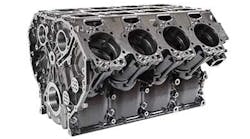Manufacturers are doing more with fewer machines, and they need toolholding systems that can keep up.
Toolholding systems, such as the one from Sandvik, combine modularity and rigidity for both short and long reaches. This can maximize tooling investments.
Because of its polygon-shaped coupling, a Coromant Capto toolholder centers and aligns cutting edges at a repeatability of 0.000080 in.
A Coromant Capto toolholding system's tapered polygonal shape transfers torque forces over the whole polygon, directing clamping forces back to the spindle for maximum axial clamping action to tool faces.
The front end of a Coromant system holds the cutting tool pre-loaded, centered, and pre-aligned in position, while the back end mates with the machine tool's carousel or spindle chuck.
Today, spindle uptime is running at about 20-25% nationwide. However, many metalworking shops are striving to further cut downtime by doing more with fewer machines, tools, and setups. One promising approach involves the integration of turning and rotating on a single machine.
At one time, these turn/mill centers were beyond reach for some due to price. Recently, they have become more economically attractive because manufacturers can recoup their investment faster — a compelling reason considering the price tags on these machines range from about $400,000 to approximately $750,000. Other reasons are manpower and tool rationalization, fewer setups, and better process control.
Tooling up from the start with a modular toolholding system can maximize capital investment. One such system, which combines quick-change with modularity and rigidity for short or long reaches, is Sandvik Coromant's Capto modular tooling. It is universal, fitting most CNC machines whether the tooling is stationary or rotating. It also does away with having integral square (VDI), round, or tapered shanks for turning, milling, drilling, or boring.
Instability myth
When it was first introduced, modular quick-change tooling was perceived as unstable. This myth of instability, according to Sandvik, has been disproved by tens of thousands of satisfied users, case-in-point being FMC Wellhead Equipment and Super-bolt Inc.
FMC of Houston dedicates a Sandvik Coromant Capto modular toolholder for its large and small-diameter Duobore boring as well as milling tools. Quick-change toolholding has lowered dead machine time for edge changes and job-to-job changeover by 25% on average. Edge indexing takes less than 30 sec/edge and requires no offsetting, measurements, or test cuts. As a result, the company's machine-tool productive capacity is up 33%.
According to FMC, its modular toolholder delivers repeatable accuracy and rigidity at least equal to — and sometimes better than — conventional integral or solid tooling. Sandvik's system provides 0.000080 in. (or 2.0 µm) cutting edge repeatability in length, width, and height of the same tool when reclamped. Runouts of the system are less than 0.0002 in. per coupling, and even when Coromant Capto is extended with various size shanks for long reaches, it still maintains its strength and accuracy on all three axes. Superbolt Inc., Carnegie, Pa., manufactures high-strength mechanical-fastening systems, which require a large number of threads. Job-changeover rate varies as many as three times/shift or as few as one every three to four days. In all, Superbolt produces about 200 different types and sizes of threads, each requiring a different threading insert.
Using one size Coromant Capto toolholder, Superbolt has reduced toolholding requirements by an unexpected 50%. One toolholder, as opposed to two previously, accommodates the inserts needed to generate all large threads.
Another advantage for Super-bolt is the elimination of machining steps. With its former tool-holding system, the company had to stop to measure and verify accurate repeatability. This entailed operators measuring and offsetting edges each time they swapped tools. They would then run test cuts on the first and second pieces, which may have been scrapped. This scrap was part of determining optimum speeds and feeds, as well as calculating the "differential analysis" on the threads, which have to be within ± 0.002 to 0.003 in. tolerance. Now, with Coromant Capto, edge positioning and center height are consistently accurate without measuring or test cutting. Operators save time changing out tools by installing them in just 15 to 30 sec, and once the tool is engaged, there are no setup changes. Because modular quick-change tooling is so entrenched in metalworking, Sandvik and Kennametal are licensing their quick-change and modular tooling systems (Kennametal's KM) to each other. Users can now go to either company for a combination of toolholding methods and tools that best fits their needs.
But why are today's modular toolholding systems so much more rigid and stable? For the Coromant Capto system, it's because of a special polygon-shaped coupling.
How it works
The Capto toolholding system consists of a back end and a front end, which lock together quickly and positively through a tapered polygonal shank. The back end mates with the machine's tool carousel or spindle chuck. The front end holds the cutting tool, all pre-loaded, centered, and prealigned in position. When operators switch tools, they only change the front end.
With conventional solid toolholding, two screws clamp tools in radial motion. Sandvik's design, on the other hand, directs clamping forces back to the spindle, which maximizes axial clamping action to tool faces. No screws are needed.
The tapered polygonal shape transfers torque forces over the whole polygon, so it maintains a conventional-solid-tool precision along with equal or better rigidity.
A self-centering and self-aligning effect of the polygon coupling ensures a total indicator runout (TIR) of less than 0.0002 in./coupling.
In all, the Coromant Capto modular tool system includes five coupling sizes from 1.260 to 4.21 in. (32 to 100 mm) with a full assortment of turning, milling, drilling, boring, and tapping tools for practically all metalworking applications.
Calculating your ROIHere's information to help compare the return on investment (ROI) for Coromant Capto versus conventional toolholding:
Use the following factors to calculate:
Annual savings are computed as follows: Total hours saved 3 machine burden rate = Total annual savings Tooling investment = Payback in years Total annual savings | |||||||||||||||










